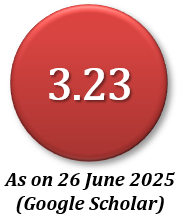Temporal land-use change of a reclaimed land in greater Dhaka and its impact on natural water cycle
Abstract
This study aims to explore the land-use induced impact on runoff and recharge of an impending urban growth on reclaimed land filled with sands in greater Dhaka to concede the low impact development through practicable methods. Having analyzed the temporal land-use change by Curve Number (CN), GIS-based Soil Conservation Service - Curve Number (SCS-CN) method has been used to evaluate the runoff of the study area. Initial land-use in 2010 with a higher CN 86 resulted in a lower CN 72 in 2020-2022 due to land-use change (pre-developed/existing condition) with permeable soil for urban development. However, the gradual land-use change resulted in more imperviousness and an increasing trend in CN. With ultimate CN 84, approximately 243% more runoff was predicted during complete urbanization in 2040 and beyond as opposed to CN 72 in 2020-2022. Due to the existing higher groundwater table of the area, the Water Table Fluctuation (WTF) method has been used to find the natural recharge potential. As higher CN results in more runoff and recharge loss, ultimate natural recharge potential with CN 84 declines to more than 50% of the pre-developed condition. Results from the methods suggested a comprehensive hydrological forecasting due to land-use change on reclaimed land with assorted options for natural water cycle balance.
Downloads
References
BIGD 2019 State of Cities 2018: Water Governance in Dhaka, Brac Institute of Governance and Development (BIGD), Brac University, Dhaka, Bangladesh. https://bigd.bracu.ac.bd/publications/state-of-cities-2018-water-governance-in-dhaka/
Bird, J., Li, Y., Rahman, H. Z., Rama, M. & Venables, A. J. 2018 Toward Great Dhaka: A New Urban Development Paradigm Eastward Directions in Development, Washington, DC: World Bank, 2018.
BWDB 2011 Quantification of Gradual Fall of Ground Water Table of Dhaka City in Bangladesh, Report by the Bangladesh Water Development Board (BWDB) in 2011.
Demographia 2021 World Urban Areas, 2021. Built-Up Urban Areas or Urban Agglomerations, 17th Annual Edition, 2021. Available: http://www.demographia.com/db-worldua.pdf
DU 2014 A Report on Geological and Geotechnical Engineering Survey for Proposed Jolshiri Abashon, Department of Disaster Science of Management, University of Dhaka.
DWASA 2020 Annual Report 2020, Dhaka Water Supply and Sewerage Authority (DWASA), Dhaka, Bangladesh.
GOB 2008 Dhaka Megacity Building Construction, Improvement, Preservation and Removal Rules, Bangladesh Gazette, 29 May 2008, Ministry of Housing and Public Works, Government of the People’s Republic of Bangladesh. https://www.dpp.gov.bd/bgpress/index.php/document/extraordinary_gazettes_month_wise/2008
GOB 2018 Bangladesh Delta Plan 2100, Baseline Studies on Water Resources Management, Volume 1, Part A, General Economics Division. Bangladesh Planning Commission, Ministry of Planning, Government of the People’s Republic of Bangladesh. https://bdp2100kp.gov.bd/
GOB 2020 Bangladesh National Building Code (BNBC) 2020, Bangladesh Gazette, 11 February 2020, Ministry of Housing and Public Works, Government of the People’s Republic of Bangladesh. https://www.dpp.gov.bd/bgpress/index.php/document/get_extraordinary/39201
GOB 2022 Detailed Area Plan (DAP) 2022-35, Bangladesh Gazette, 2 August 2022, Ministry of Housing and Public Works, Government of the People’s Republic of Bangladesh. https://rajuk.portal.gov.bd/sites/default/files/files/rajuk.portal.gov.bd/miscellaneous_info/2ff79c67_bbcb_4836_aae3_de29725abe44/2023-08-06-05-58-9f77d3ce0d888a01ea1d8cf440e986dd.pdf
Harbor, J.M. (1994) A Practical Method for Estimating the Impact of Land-Use Change on Surface Runoff, Groundwater Recharge and Wetland Hydrology, Journal of the American Planning Association, 60(1), pp. 95-108.
Healy, R. W. and Cook, P. G. (2002) Using Groundwater Levels to Estimate Recharge. Hydrogeology Journal, vol. 10, pp. 91-109.
Hoque, M.A., Hoque, M.M., and Ahmed, K.M. (2007) Declining Groundwater Level and Aquifer Dewatering in Dhaka Metropolitan Area, Bangladesh: Causes and Quantification, Hydrogeology Journal, vol. 15, pp. 1523–1534.
Huq, M. H. and Rahman, M. M. 2020 Land-Use and Land-Cover Change in Dhaka Eastern Region and its Impact on Surface Run-off. MIST International Journal of Science and Technology, 8(1), 35–47. DOI: https://doi.org/10.47981/j.mijst.08(01)2020.169(35-47).
Huq, H. M. 2017 A Study on Land-Use and Land-Cover Change of Dhaka Eastern Region and Its Impact on Water Cycle, Master’s Thesis, Bangladesh University of Engineering and Technology, Dhaka, Bangladesh, (BUET Library).
Iftekhar, M.S. & Islam, M.R. (2022) How to transform Dhaka into a water sensitive city? Urban Water Journal, DOI: 10.1080/1573062X.2022.2026983.
Islam, M.S., Aramaki, T. & Hanaki, K. 2005 Development and Application of an Integrated Water Balance Model to Study the Sensitivity of the Tokyo Metropolitan Area Water Availability Scenario to Climatic Changes. Water Resour Manage 19, 423–445 (2005). https://doi.org/10.1007/s11269-005-3277-1
IPCC 2022 Climate Change 2022: Impacts, Adaptation, and Vulnerability. Contribution of Working Group II to the Sixth Assessment Report of the Intergovernmental Panel on Climate Change [H.-O. Pörtner, D.C. Roberts, M. Tignor, E.S. Poloczanska, K. Mintenbeck, A. Alegría, M. Craig, S. Langsdorf, S. Löschke, V. Möller, A. Okem, B. Rama (eds.)]. Cambridge University Press. https://www.ipcc.ch/report/ar6/wg2/
JICA & DTCA 2015 The Project on the Revision and Updating of the Strategic, Transport Plan for Dhaka, Draft Final Report. https://dtca.portal.gov.bd/sites/default/files/files/dtca.portal.gov.bd/page/ff5b3474_c035_49d2_9d4e_092a74fd8a8e/DFR_UrbanTransport%20Policy%20%28Edited%29.pdf
Jolshiri Authority 2015 Masterplan of Jolshiri Residential Development, Dhaka, Bangladesh. https://jolshiri.army.mil.bd/
Karim, K. R. (2014) Trends of Permanent Wetland Change in Detailed Area Plan of Dhaka, American Journal of Water Resources, vol. 2, no. 5, pp. 106–09, 2014.
RAJUK (2015) Dhaka Structure Plan (2016-2035), Regional Development Planning (RDP), Rajdhani Unnayan Kartripakkha (RAJUK), Ministry of Housing and Public Works, Government of the People’s Republic of Bangladesh. https://rajuk.portal.gov.bd/sites/default/files/files/rajuk.portal.gov.bd/page/0a05e9d0_03f7_48e4_bfd5_cad5fbcd5e23/2021-06-22-08-35-c8b98a96d0cadc8d87fa1c61f56966bb.pdf
Shamsudduha, M., Chandler, R. E., Taylor, R. G. & Ahmed, K. M. (2009) Recent Trends in Groundwater Levels in a Highly Seasonal Hydrological System: the Ganges-Brahmaputra-Meghna Delta, Hydrol. Earth Syst. Sci., vol. 13, pp. 2373–2385.
Sinha, B.P.C. & Sharma, S.K. (1988) Natural ground water recharge estimation methodologies in India. In Estimation of natural groundwater recharge (pp. 301-311). Springer, Dordrecht.
Subrina, S. & Chowdhury, F. K. (2018). Urban Dynamics: An undervalued issue for waterlogging disaster risk management in case of Dhaka city, Bangladesh, Procedia Engineering, vol. 212, pp. 801-808.
UN 2018 World Urbanization Prospects: The 2018 Revision. New York: Department of Economic and Social Affairs, Population Division, UN. https://www.un-ilibrary.org/content/books/9789210043144
UN 2022 Sustainable Development Goals Report 2022, New York: Department of Economic and Social Affairs, Sustainable Development, UN. https://unstats.un.org/sdgs/report/2022/
UNESCO 2019 The United Nations World Water Development Report 2019: Leaving No One Behind, UNESCO World Water Assessment Programme, Paris, UNESCO. https://www.unesco.org/en/wwap/wwdr/2019
UNESCO 2020 UN-Water 2020: United Nations World Water Development Report 2020: Water and Climate Change, Paris, UNESCO. https://www.unwater.org/publications/un-world-water-development-report-2020
UN-Habitat 2020 World Cities Report 2020- The Value of Sustainable Urbanization, United Nations Human Settlements Programme. https://unhabitat.org/sites/default/files/2020/10/wcr_2020_report.pdf
USDA 1986. Soil Conservation Service, Urban Hydrology for Small Watersheds, Technical Relese: TR-55, Washington, DC. https://www.nrc.gov/docs/ML1421/ML14219A437.pdf
Ward, A.D., Trimble, S.W. and Wolman, M.G. 2004 Environmental Hydrology, 2nd Edition, Lewis Publishers, CRC Press.
World Bank 2018 Enhancing Opportunities for Clean and Resilient Growth in Urban Bangladesh, Country Environmental Analysis 2018, World Bank, Washington, DC. https://elibrary.worldbank.org/doi/abs/10.1596/30558
MIJST follows the open access policy.

This work is licensed under a Creative Commons Attribution-NonCommercial 4.0 International License. This allows anyone to copy, share, distribute, and modify the work for non-commercial purposes, where the original work and source should be properly credited.
















